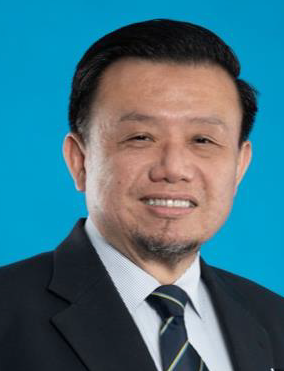Biodata

Prof. Datuk ChM. Ts. Dr. Taufiq Yap Yun Hin PJN, PGDK, FASc, FMIC, FRSC, CChem., AMIChemE, MMSET
Head of Catalysis Science and Technology Research Centre, Faculty of Science, Universiti Putra Malaysia (UPM), Malaysia.
Professor Taufiq Yap Yun Hin was born in Kota Kinabalu, Sabah on 14th January 1968. He earned his BSc (Hons) and MSc in 1992 and 1994, respectively at Universiti Putra Malaysia. He then went on to earn his PhD (1997) in heterogeneous catalysis at University of Manchester Institute of Science and Technology (UMIST), United Kingdom.
Professor Taufiq-Yap started his career as a tutor in July 1993 and then lecturer at the Department of Chemistry, Universiti Putra Malaysia (UPM) since August 1997. He was promoted to Associate Professor on 1st May 2002 and to full professor on 1st October 2007. He was the founding Head of Catalysis Science and Technology Research Centre (PutraCAT) from 1st Sept 2008 until Sept 2014. Professor Taufiq-Yap was appointed as Vice Chancellor of Universiti Malaysia Sabah from July 2019 – July 2022. His research interest lies in the catalytic production of bioenergy from biomass and wastes. He published more than 470 Scopus indexed scientific publications includes various reviews on biodiesel and hydrogen production. Throughout his career, Professor Taufiq-Yap has been the recipient of the following Awards and Distinctions: National Young Scientist Award (2002); The Outstanding Young Malaysian Award (2008), Top Research Scientist Malaysia (2013), Malaysia’s Research STAR Award (2018) and listed as World’s Top 2% Scientist by Stanford University, USA. He received the highest award Gold Medal for Excellent in Chemistry 2022. Professor Taufiq-Yap was appointed as Fellow of Academy Science of Malaysia (2015), Fellow, Malaysia Institute of Chemistry (2009) and Fellow, Royal Society of Chemistry, United Kingdom (2008); He is currently the Visiting Professor of Henan Agriculture University, China (2020-2025).
Speech detail
Sustainable Biohydrogen from Biomass
Hydrogen (H2) is a one of the utmost competent alternative clean fuels in the transition to net-zero emissions for the future which can be used for transportation and stationary power generation. H2 is the alternative to fossil fuels in terms of the green economy, attributed to its merits, such as availability, renewability, and high energy content (approximately three times higher than gasoline) and produces no direct emissions of pollutants or greenhouse gases. One of the advantages is that H2 can be stored/transported in different valuable forms i.e. solid, liquid and compressed gas. Among the most renewable energies, one of the most important energy sources near future for hydrogen production is biomass. There are two main routes for biomass-based hydrogen production, namely thermo-chemical and bio-chemical. Three methods that included as thermo-chemical routes are pyrolysis, gasification and supercritical water gasification whereas biological conversion methods consist of fermentative hydrogen production, photosynthesis and biological water gas shift reactions. Biomass gasification is a possible alternative to the direct use of fuel energy. Biomass, a CO2 neutral source of renewable fuel, can contribute to the demand for heat, electricity and synthesis gas. Biomass derived hydrogen can be classified as carbon neutral because the CO2 released during hydrogen (syngas) production is consumed by further biomass generation. The major constituents of biomass are cellulose, hemicelluloses, lignin, inorganic extractives, and inorganic minerals. Lignocellulosic biomasses include agricultural crop waste, forest residues, aquatic plants, energy crops residues etc and are about 50% of the all biomasses. Lignocellulosic biomass is the most promising renewable feedstocks for production of biofuels and chemicals. Currently, lignocellulosic biomass resources deserve major interest to produce bio-oil, bioethanol, synthesis gas, hydrogen and chemical.

